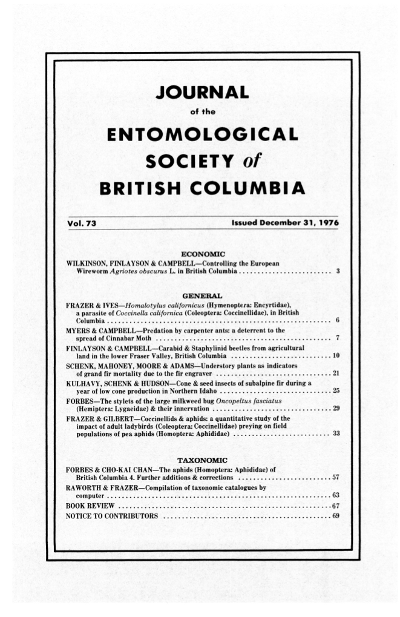Coccinellids and aphids: A quantitative study of the impact of adult ladybirds (Coleoptera: Coccinellidae) preying on field populations of pea aphids (Homoptera: Aphididae)
Keywords:
pea aphid, Homoptera, Aphididae, ladybirds, Coleoptera, CoccinellidaeAbstract
This paper examines the quantitative effect of predation by a ladybird beetle, <i>Coccinella trifasciata</i>, on field populations of pea aphid, <i>Acyrthosiphon pisum</i>. Field studies showed that no mathematical function, involving only the current densities of predator and prey, can predict the true predation rate. We studied the components of the predation process in detail , first in the laboratory, and then in the field. We derived a new, empirical (not theoretical) formula for predation rate, which includes predator and prey densities, predator voracity, prey age-distribution, and temperature. Temperature has a single effect on the rate of aphid development, but a double effect on the predation rate, so that coccinellids are much more effective predators at high temperatures, than at low. Field cage experiments, with known numbers of beetles, revealed that all current methods of counting adult coccinellids in the field greatly underestimate their true numbers. When this fault is rectified, the new formula correctly predicts the predation rate. The study shows that it is possible to investigate a predator∑prey relationship, in the field, in considerable detail, in order to predict the predation rate over a wide range of circumstances. The study reveals several sharp, qualitative, differences between the predation relationship observed in the laboratory, and the same relationship observed in the field. All laboratory studies must therefore be suspect, until verified in the field. In particular, arthropod predation studies must allow for effects of temperature on both predation rate and prey population dynamics. The coccinellid∑aphid relationship permits no equilibrium, or steady state, so that conventional definitions of stability do not apply. The coccinellid's functional response is inherently unstable: the relationship is stabilized solely by a numerical response. Implications for biological control are discussed.References
Campbell, A., B.D. Frazer, N. Gilbert, A.P. Gutierrez, and M. Mackauer. 1974. Temperature requirements of some aphids and their parasites. J. Appl. Ecol. 11:431-438.
DeBach, P. 1974. Biological control by natural enemies. Cambridge University Press. Cambridge.
Dixon, A.F.G. 1959. An experimental study of the searching behaviour of the predatory coccinellid beetle Adalia bipunctata (L) J. Anim. Ecol. 28:259-281.
Frazer, B.D. and R. van den Bosch. 1973. Biological control of the walnut aphid in California: The interrelationship of the aphid and its parasite. Environ Ent. 2:561 -568.
Gilbert, N. and A.P. Gutierrez. 1973. A plant-aphid-parasite relationship. J. Anim. Ecol. 42:323-340.
Gilbert, N. and H.D. Hughes. 1971. A model of an aphid population-three adventures. J. Anim. Ecol. 40:525-534.
Gutierrez, A.P., D.J. Morgan, and D.E. Havenstein. 1971. The ecology of Aphis craccivora Koch and subterranean clover stunt virus. I, the phenology of aphid populations and the epidemiology of virus in pastures in south-east Australia. J. Appl. Ecol. 8:699-72l.
Gutierrez, A.P., D.E. Havenstein, H.A. Nix, and P.A. Moore. 1974a. The ecology of Aphis craccivora Koch and subterranean clover stunt virus II. A model of cowpea aphid populations in temperate pastures. J. Appl. Ecol. 11:1-20.
Gutierrez, A.P., D.E. Havenstein, H.A. Nix, and P.A. Moore. 1974b. The ecology of Aphis craccivora Koch and subterranean clover stunt virus III. A regional perspective of the phenology and migration of the cowpea aphid. J. Appl. Ecol. 11:21-35.
Hassell, M.P. 1969. A population model for the interaction between Cyzenis albicans (Fall.)(Tachinidae) and Operophtera brumata (l.) (Geometridae) at Wytham, Berkshire. J. Anim. Ecol. 38:567-576.
Hassell, M.P. and R.M. May. 1973. Stability in insect host-parasite models. J. Anim. Ecol. 42:693-726.
Holling, C.S. 1964. The analysis of complex population processes. Can. Ent. 96:335-347.
Holling, C.S. 1966. The functional response of invertebrate predators to prey density. Mem. Ent. Soc. Can. No. 48.
Holling, C.S. 1973. Resilience and stability of ecological systems. Ann. rev. Ecol.& systematics 4:1-23.
Huffaker, C.B., K.P. Shea, and S.G. Herman. 1963. Experimental studies on predation: complex dispersion and levels of food in a acarine predator-prey interaction. Hilgardia 34:305-330.
Hughes, R.D. 1963. Population dynamics of the cabbage aphid Brevicoryne brassicae (L.) J. Anim. Ecol. 32:393-424.
Hughes, R.D. and N. Gilbert. 1968. A model of an aphid population - a general statement. J. Anim. Ecol. 37:553-563.
Morris, R.R. et al. 1963. The dynamics of epidemic spruce bud worm populations. Mem. Ent. Soc. Can. No. 31.
Morris, R.F. and C.W. Bennett. 1967. Seasonal population trends and extensive census methods for Hyphantria cunea. Can. Ent. 99:9-17.
Wratten, S.D. 1973. The effectiveness of the coccinellid beetle, Adalia bipunctata (L), as a predator of the lime aphid, Eueallipterus tiliae L. J. Anim. Ecol. 42:785-802.
Downloads
Published
Issue
Section
License
Authors who publish with the Journal of the Entomological Society of British Columbia agree to the following terms:
-Authors retain copyright and grant the journal right of first publication with the work simultaneously licensed under a Creative Commons Attribution License that allows others to share the work with an acknowledgement of the work's authorship and initial publication in this journal.
-Authors are able to enter into separate, additional contractual arrangements for the non-exclusive distribution of the journal's published version of the work (e.g., post it to an institutional repository or publish it in a book), with an acknowledgement of its initial publication in this journal.
-Authors are permitted and encouraged to post their work online (e.g., in institutional repositories or on their website) prior to and during the submission process, as it can lead to productive exchanges, as well as earlier and greater citation of published work (See The Effect of Open Access).


